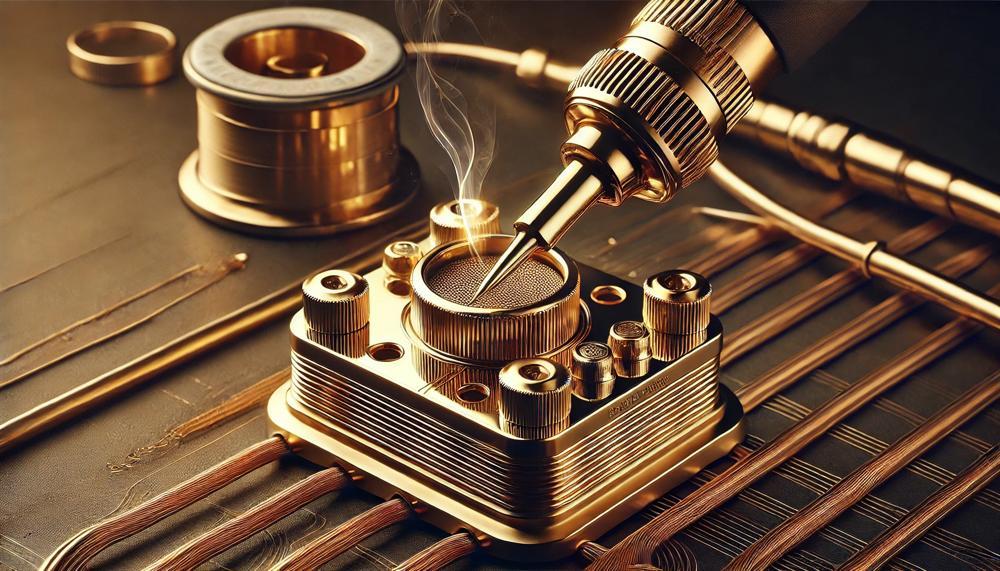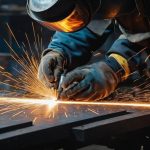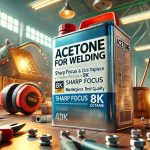Today, we’re diving deep into the realm of soldering brass to brass, a process that might sound simple at first but holds its own set of challenges and techniques.
Whether you’re a seasoned craftsman, a hobbyist looking to expand your skills, or just curious about how things are made, this exploration will shed light on the intricacies of working with brass, a popular material known for its beauty and durability.
Here’s what you’ll discover in our journey through the heat, metal, and flux:
- The Essentials of Brass: Understand why brass is a go-to material for various projects and what makes it unique.
- Preparation Is Key: Learn about the crucial steps in preparing brass for soldering to ensure a clean, strong bond.
- Choosing the Right Solder: Not all solders are created equal. Find out which types are best suited for brass and why.
- Technique Matters: Get to grips with the soldering process, including tips and tricks for achieving professional results.
- Troubleshooting Common Issues: Identify potential pitfalls and learn how to avoid or rectify them, ensuring your projects turn out perfectly.
By the end of this post, you’ll not only appreciate the beauty of brass and the skill involved in soldering it to itself but also be equipped with the knowledge to tackle your own brass projects with confidence. Let’s heat up the soldering iron and begin our adventure into the golden world of brass.
Contents
What is Soldering?
Soldering, a craft known by many but mastered by few, stands as the art of joining metals not through brute force but through finesse and precision. It’s akin to painting with fire and metal, where the solder, a fusible metal alloy, serves as the brush, and the metals to be joined are the canvas.
In essence, soldering allows two pieces of metal, such as brass, to become one without the metals themselves melting, relying instead on the melting of the solder to create the bond.
Process of Soldering Brass to Brass:
- Preparation is Key: The journey begins with ensuring the brass pieces are pristine, free from any blemishes of oxidation or contamination. This cleanliness is not just about aesthetics; it’s about integrity, for even the smallest speck of dirt can weaken the bond.
- A Flux of Clarity: Flux, more than just a chemical, is the guiding light that cleans and prepares the surface, ensuring the solder flows where it should, like a river following its course.
- The Dance of Heat: With a soldering iron or torch in hand, one must approach the brass with a gentle yet firm touch, heating it evenly but not to the point of altering its shape or essence.
- Union Through Solder: As the brass reaches the perfect warmth, like a sun-kissed morning, the solder is introduced, not forcefully, but delicately, melting and flowing into the union, filling the gap between the brass pieces with a bond as strong as the materials it joins.
- Cooling – The Silent Guardian: Patience is a virtue here, as the newly formed bond must be allowed to cool, undisturbed, like a lake under a winter’s night, ensuring the strength and longevity of the connection.
- The Final Touch: A clean, damp cloth, perhaps, to wipe away any residual flux, ensuring the joint not only holds strong but also looks clean and professional.
Safety and Precision:
- The Shield of Gloves: Protect the hands, for they are the tools of your craft.
- The Vigilance Against Overheating: Keep a watchful eye, for too much heat can betray the brass and the bond.
- The Respect for the Craft: Always remember, soldering is not just about joining metals; it’s about doing so with respect for the materials, the process, and the final product.
In the realm of metals, soldering brass to brass is akin to weaving a tapestry with threads of gold.
Can You Solder Brass To Brass?
Yes, soldering brass to brass is not only possible but also a commonly employed method in various fields such as plumbing, jewellery making, and electronics for creating a robust and lasting bond between two pieces of brass.
This technique demands the right combination of heat, solder, and flux to achieve a successful join. Let’s break down the essentials for soldering brass together effectively.
Essentials for Soldering Brass:

- Preparation: Clean the brass pieces thoroughly to remove any dirt, grease, or oxidation. A clean surface ensures better adhesion.
- Flux: Application of flux is critical to prevent oxidation during the soldering process and to help the solder flow smoothly over the joint area.
- Heat Source: A soldering iron or torch suitable for the brass thickness is necessary to evenly heat the pieces to be joined.
- Solder: Use a solder that is compatible with brass, typically a lead-free or silver solder, which melts and flows at the right temperature to form the bond.
Steps for Successful Brass Soldering:
- Clean the brass surfaces.
- Apply flux to the joint area.
- Heat the pieces evenly, avoiding overheating.
- Introduce the solder to the joint when the brass reaches the appropriate temperature.
Allow the joint to cool naturally without disturbing it.
Table of Soldering Brass Essentials:
| Material/Tool | Function | Importance |
| Flux | Prevents oxidation | Essential for clean join |
| Heat Source | Heats the brass | Must match brass thickness |
| Solder | Binds the brass | Choose lead-free or silver |
By adhering to these guidelines and employing the right materials and techniques, soldering brass to brass becomes a manageable task, yielding a strong and durable bond suitable for a wide range of applications.
What Are the Challenges of Soldering Brass to Brass?
Soldering brass to brass presents unique challenges, often due to the material’s specific properties and the soldering process itself. The following table outlines common problems and considerations when attempting to solder brass to brass:
| Challenge | Description | Solution |
| Proper Cleaning | Brass can develop an oxide layer that impedes adhesion. | Thoroughly clean surfaces with a suitable solvent or mechanical action to remove oxides and contaminants. |
| Correct Flux Use | Flux is essential for cleaning and promoting solder flow but must be compatible with brass. | Choose a flux specifically designed for soldering brass to help remove oxides and prevent re-oxidation during heating. |
| Solder Selection | Choosing the right solder alloy is crucial, as some have too high a melting point. | Opt for a silver-based solder alloy that has a lower melting point than brass but sufficient strength for the application. |
| Heat Management | Uneven or excessive heat can damage brass or result in weak joints. | Apply heat evenly and carefully, using just enough to melt the solder without overheating the brass. |
| Surface Compatibility | Surface contamination or incompatibility can lead to poor bond strength. | Ensure surfaces are free of contaminants and properly prepared to promote good adhesion. |
In summary, the trick to successfully soldering brass to brass lies in meticulous surface preparation, choosing the right materials (flux and solder), and careful heat application.
What Solder Alloy Should Be Used to Join Two Pieces of Brass?
To fuse two pieces of brass together, your go-to should be a solder alloy that’s not just effective but also suitable for the brass’s unique characteristics. Let’s zero in on a trio of solder alloys that are up to the task, ensuring your brass bonding is nothing short of stellar.
- Lead-Free Silver Solder: A top pick for its excellent flow properties and the strong, durable joints it forms. It’s a sterling choice for projects where strength is paramount.
- Tin-Silver Alloy Solder: Boasts a lower melting point, making it a breeze to work with, especially for those newer to soldering. It’s kind to your brass and less likely to cause overheating issues.
- Tin-Lead Solder (for non-potable applications): While it’s an old-school option, its ease of use and reliable bonding make it a contender. However, it’s crucial to note its suitability is restricted to projects not involving drinking water.
For your brass-joining ventures, here’s a handy table laying out these solder alloys:
| Solder Alloy | Benefits | Best Used For |
| Lead-Free Silver Solder | Strong, durable joints; excellent flow | Structural applications needing high strength |
| Tin-Silver Alloy Solder | Lower melting point, easy to use | General soldering, especially for beginners |
| Tin-Lead Solder | Easy to use, reliable bonding | Non-potable applications where safety is not a concern |
When joining brass pieces, remember to start with a clean slate by thoroughly prepping your surfaces. A bit of elbow grease and the right solder can turn a tricky task into a triumph.
How To Prepare The Surface for Soldering?
To ensure a successful soldering of brass to brass, meticulous preparation and precise execution are paramount. Here’s a breakdown of the steps involved:
Choosing the Right Solder:
Opt for a silver-based solder to avoid damaging the brass due to its lower melting point.
Cleaning the Surfaces:
It is critical to scrub both brass items, banishing any dirt, grease, or oxidation.
Applying the Right Flux:
Use brass-specific flux to combat any lingering oxidation and boost solder flow.
Heating the Joint:
Warm the joint area gradually and uniformly, steering clear of any warping.
Applying the Solder:
Employ the chosen solder alloy wisely to forge a durable bond.
Post-Soldering Cleanup:
After cooling, eradicate any flux remnants to avert corrosion.
See the detailed table below for a clear understanding:
| Step | Action | Purpose |
| Selecting Solder | Use silver-based solder. | Prevents brass damage with a suitable melting point. |
| Cleaning Surfaces | Thorough cleaning of brass pieces. | Ensures clean surfaces for effective adhesion. |
| Applying Flux | Use brass-specific flux. | Enhances solder flow and combat oxidation. |
| Heating Joint | Even and slow heating. | Avoids material warping and ensures even solder flow. |
| Applying Solder | Use the right alloy. | Establishes a robust bond between brass components. |
| Cleanup | Remove flux residue post-cooling. | Prevents corrosion and ensures joint longevity. |
How To Successfully Solder Brass to Brass?
To solder brass to brass with finesse and ensure a bond that’s both sturdy and lasting, follow these detailed steps. The key lies in meticulous preparation, precise application, and a touch of craftsmanship.
| Step | Action | Details |
| Select Solder | Opt for Silver-based Solder | Choose a silver-based solder for its lower melting point and superior bonding strength. |
| Clean Surfaces | Use Sandpaper or Wire Brushes | Scrub off any grime, oil, or tarnish to ensure a clean surface for effective soldering. |
| Apply Flux | Use Acid-based Flux for Brass | Acid-based flux prepares the brass, aiding in solder flow and oxidation removal. |
| Heat the Joint | Evenly Apply Heat with a Torch | Warm the joint area gradually, avoiding any damage or warping to the brass. |
| Apply Solder | Introduce Solder at the Right Temperature | When the brass is suitably hot, add solder to one side, allowing capillary action to pull it through the joint. |
| Clean Residue | Brush Off with Wire Brush and Water | Post-cooling, remove any leftover flux with a wire brush, ensuring a clean finish. |
| Ensure Compatibility | Check Alloy and Brass Compatibility | Ensure the solder alloy’s melting point is below that of the brass for a durable bond. |
Remember, patience and a steady hand are your allies in achieving a seamless solder. Each step, from choosing the right solder to the final cleaning, contributes to the strength and longevity of the bond.
Conclusion
Soldering brass to brass, a task that intertwines artistry with precision, is a journey through the meticulous world of metalwork. This article illuminates the process, emphasizing not just the “how” but the “why” behind each step. Brass, celebrated for its resilience and allure, demands a special approach. The keys to a strong, enduring bond are thorough preparation, suitable solder and flux selection, and skilled heat application.
Every step, from cleansing the brass surfaces of any oxidation to carefully applying heat and solder, plays a pivotal role in the success of the soldering process. Selecting the correct solder—typically a lead-free or silver alloy—is crucial, as it ensures a bond that is both strong and suitable for the brass’s characteristics. Flux, a hero in its own right, prevents oxidation during heating and aids the solder in flowing smoothly.
Patience and precision are your guiding stars in this process. A gentle touch, a keen eye for temperature, and an appreciation for the material lead to a bond that’s not just mechanically sound but aesthetically pleasing. The article, rich in detail, walks you through each phase, offering solutions to common challenges and insight into the nuances of working with brass.





